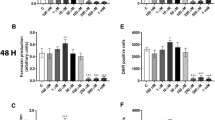Abstract
In this study, to discuss the importance of the cell cycle distribution in cell-based in vitro toxicity mechanism studies, diethyl sulfate (DES) was selected as a model chemical that induced the alteration of the cell cycle distribution in human bronchial epithelial cell line 16HBE 14o- (HBE) cells. Cells were treated with various concentrations of DES, cell proliferation and apoptosis were then determined. The results showed that DES concentration-dependently inhibited HBE cells proliferation and induced apoptosis. When cells were treated with 2.0 mM of DES for 20 or 28 h, significant S and G2/M phase accumulation was observed. Then, the relative cellular levels of Cdk4, p-Cdk2 (Thr160), Cyclins A and B1 in DES-treated HBE cells at 20 and 28 h were determined by two ways. The differences of the cell cycle distribution between DES and control groups were ignored in one way and eliminated by using flow cytometric cell sorting in the other. The results obtained by the two ways were quite different, which indicated that the cell cycle distribution might result in confounding if it was significantly different between the treated and control groups. Therefore, we propose that the cell cycle distribution should be given more consideration in cell-based in vitro toxicological studies.




Similar content being viewed by others
References
Bai H, Madabushi A, Guan X, Lu AL (2010) Interaction between human mismatch repair recognition proteins and checkpoint sensor Rad9–Rad1–Hus1. DNA Repair (Amst) 9:478–487
Beardsley DI, Kim WJ, Brown KD (2005) N-methyl-N’-nitro-N-nitrosoguanidine activates cell-cycle arrest through distinct mechanisms activated in a dose-dependent manner. Mol Pharmacol 68:1049–1060
Bonita R, Beaglehole R, Kjellström T (2006) Types of studies. In: Bonita R, Beaglehole R, Kjellström T (eds) Basic epidemiology, 2nd edn. World Health Organization, Geneva, pp 39–61
Cooper S, Paulsen M, Ljungman M, Vu-Phan D, Kim D, Gonzalez-Hernandez M (2007) Membrane-elution analysis of content of cyclins A, B1, and E during the unperturbed mammalian cell cycle. Cell Div 2:28
Cozens AL, Yezzi MJ, Kunzelmann K, Ohrui T, Chin L, Eng K, Finkbeiner WE, Widdicombe JH, Gruenert DC (1994) CFTR expression and chloride secretion in polarized immortal human bronchial epithelial cells. Am J Respir Cell Mol Biol 10:38–47
Hu E, Fu J, Zhao P, Yao B, Qi Y, Yuan Z, Zhou Z (2010) Diethyl sulfate induced Cdk2-dependent centrosome amplification in CHL cells. Toxicology 275:58–64
Jeffy BD, Chen EJ, Gudas JM, Romagnolo DF (2000) Disruption of cell cycle kinetics by benzo[a]pyrene: inverse expression patterns of BRCA-1 and p53 in MCF-7 cells arrested in S and G2. Neoplasia 2:460–470
National Research Council (NRC) (2007) Toxicity testing in the twenty-first century: a vision and a strategy. National Academy Press, Washington, DC
Oh S, Im H, Oh E, Lee J, Khim JY, Mun J, Kim Y, Lee E, Kim J, Sul D (2004) Effects of benzo(a)pyrene on protein expression in Jurkat T-cells. Proteomics 4:3514–3526
Pang Y, Li W, Ma R, Ji W, Wang Q, Li D, Xiao Y, Wei Q, Lai Y, Yang P, Chen L, Tang S, Lin Y, Zhuang Z, Zheng Y, Chen W (2008) Development of human cell models for assessing the carcinogenic potential of chemicals. Toxicol Appl Pharmacol 232:478–486
Sadikovic B, Rodenhiser DI (2006) Benzopyrene exposure disrupts DNA methylation and growth dynamics in breast cancer cells. Toxicol Appl Pharmacol 216:458–468
Sancar A, Lindsey-Boltz LA, Unsal-Kaçmaz K, Linn S (2004) Molecular mechanisms of mammalian DNA repair and the DNA damage checkpoints. Annu Rev Biochem 73:39–85
Shen J, Chen W, Yin X, Yu Y (2008) Proteomic analysis of different temporal expression patterns induced by N-methyl-N’-nitro-N-nitrosoguanidine treatment. J Proteome Res 7:2999–3009
Stewart A (2002) Case-control studies. In: Stewart A (ed) Basic statistics and epidemiology: a practical guide. Radcliffe Medical Press, Oxford, pp 103–106
van Delft JH, Mathijs K, Staal YC, van Herwijnen MH, Brauers KJ, Boorsma A, Kleinjans JC (2010) Time series analysis of benzo[A]pyrene-induced transcriptome changes suggests that a network of transcription factors regulates the effects on functional gene sets. Toxicol Sci 117:381–392
Zhao P, Zhong W, Ying X, Yuan Z, Fu J, Zhou Z (2008) Manganese chloride-induced G0/G1 and S phase arrest in A549 cells. Toxicology 250:39–46
Zhao P, Zhong W, Ying X, Yao B, Yuan Z, Fu J, Zhou Z (2010) Comparative proteomic analysis of anti-benzo(a)pyrene-7,8-dihydrodiol-9,10-epoxide-transformed and normal human bronchial epithelial G0/G1 cells. Chem Biol Interact 186:166–173
Acknowledgments
This work was supported by National Natural Science Foundation of China Grant 81001253; Beijing Natural Science Foundation Grant 7132122; and Fundamental Research Funds for the Central Universities Grant BMU20090460.
Conflict of interest
There is no conflict of interest.
Author information
Authors and Affiliations
Corresponding author
Electronic Supplementary Material
Below is the link to the electronic Supplementary Material.
Rights and permissions
About this article
Cite this article
Zhao, P., Fu, J., Yao, B. et al. The cell cycle distribution should be given more consideration in cell-based in vitro toxicological studies. Arch Toxicol 88, 337–343 (2014). https://doi.org/10.1007/s00204-013-1103-8
Received:
Accepted:
Published:
Issue Date:
DOI: https://doi.org/10.1007/s00204-013-1103-8




